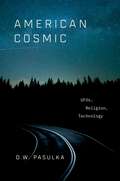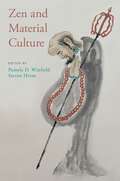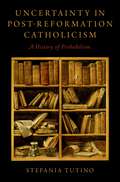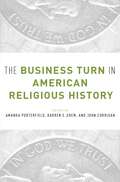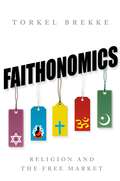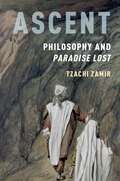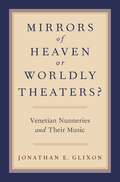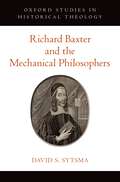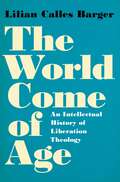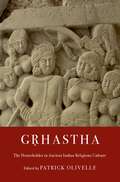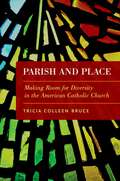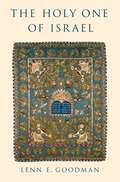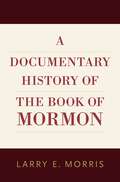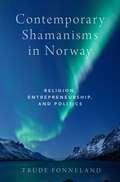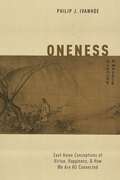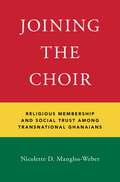- Table View
- List View
American Cosmic: UFOs, Religion, Technology
by D.W. PasulkaMore than half of American adults and more than seventy-five percent of young Americans believe in intelligent extraterrestrial life. This level of belief rivals that of belief in God. American Cosmic examines the mechanisms at work behind the thriving belief system in extraterrestrial life, a system that is changing and even supplanting traditional religions. Over the course of a six-year ethnographic study, D.W. Pasulka interviewed successful and influential scientists, professionals, and Silicon Valley entrepreneurs who believe in extraterrestrial intelligence, thereby disproving the common misconception that only fringe members of society believe in UFOs. She argues that widespread belief in aliens is due to a number of factors including their ubiquity in modern media like The X-Files, which can influence memory, and the believability lent to that media by the search for planets that might support life. American Cosmic explores the intriguing question of how people interpret unexplainable experiences, and argues that the media is replacing religion as a cultural authority that offers believers answers about non-human intelligent life.
American Cosmic: UFOs, Religion, Technology
by D.W. PasulkaMore than half of American adults and more than seventy-five percent of young Americans believe in intelligent extraterrestrial life. This level of belief rivals that of belief in God. American Cosmic examines the mechanisms at work behind the thriving belief system in extraterrestrial life, a system that is changing and even supplanting traditional religions. Over the course of a six-year ethnographic study, D.W. Pasulka interviewed successful and influential scientists, professionals, and Silicon Valley entrepreneurs who believe in extraterrestrial intelligence, thereby disproving the common misconception that only fringe members of society believe in UFOs. She argues that widespread belief in aliens is due to a number of factors including their ubiquity in modern media like The X-Files, which can influence memory, and the believability lent to that media by the search for planets that might support life. American Cosmic explores the intriguing question of how people interpret unexplainable experiences, and argues that the media is replacing religion as a cultural authority that offers believers answers about non-human intelligent life.
ZEN & MATERIAL CULTURE C
by Pamela D. Winfield and Steven HeineThe stereotype of Zen Buddhism as a minimalistic or even immaterial meditative tradition persists in the Euro-American cultural imagination. This volume calls attention to the vast range of "stuff" in Zen by highlighting the material abundance and iconic range of the Soto, Rinzai, and Obaku sects in Japan. Chapters on beads, bowls, buildings, staffs, statues, rags, robes, and even retail commodities in America all shed new light on overlooked items of lay and monastic practice in both historical and contemporary perspectives. Nine authors from the cognate fields of art history, religious studies, and the history of material culture analyze these "Zen matters" in all four senses of the phrase: the interdisciplinary study of Zen's matters (objects and images) ultimately speaks to larger Zen matters (ideas, ideals) that matter (in the predicate sense) to both male and female practitioners, often because such matters (economic considerations) help to ensure the cultural and institutional survival of the tradition. Zen and Material Culture expands the study of Japanese Zen Buddhism to include material inquiry as an important complement to mainly textual, institutional, or ritual studies. It also broadens the traditional purview of art history by incorporating the visual culture of everyday Zen objects and images into the canon of recognized masterpieces by elite artists. Finally, the volume extends Japanese material and visual cultural studies into new research territory by taking up Zen's rich trove of materia liturgica and supplementing the largely secular approach to studying Japanese popular culture. This groundbreaking volume will be a resource for anyone whose interests lie at the intersection of Zen art, architecture, history, ritual, tea ceremony, women's studies, and the fine line between Buddhist materiality and materialism.
Uncertainty in Post-Reformation Catholicism: A History of Probabilism
by Stefania TutinoUncertainty in Post-Reformation Catholicism provides a historical account of early modern probabilism and its theological, intellectual, and cultural implications. First developed in the second half of the sixteenth century, probabilism represented a significant and controversial novelty in Catholic moral theology. By the second half of the seventeenth century, probabilism became and has since been associated with moral, intellectual, and cultural decadence. Stefania Tutino challenges this understanding and claims that probabilism played a central role in addressing the challenges that geographical and cultural expansions posed to traditional Catholic theology. Tutino argues that early modern theologians used probabilism to integrate major changes within the post-Reformation Catholic theological and intellectual system. Probabilist theologians realized that their time was characterized by many changes that traditional theology was not equipped to deal with, which consequently provoked an exponential growth of uncertainties, doubts, and dilemmas of conscience. Probabilism represented the result of their efforts to appreciate, come to terms with, and manage that uncertainty. Uncertainty in Post-Reformation Catholicism reinterprets probabilism as a way of dealing with moral and epistemological doubts in quickly changing times, a way that still may be useful today. Uncertainty in Post-Reformation Catholicism argues that probabilism played a central role in addressing the challenges that a geographically and intellectually expanding world posed to traditional Catholic theology. Early modern probabilist theologians realized that their time was characterized by many changes and novelties that traditional theology was not equipped to deal with, and that consequently provoked an exponential growth of uncertainties, doubts, and dilemmas of conscience. These theologians used probabilism as a means to integrate changes and novelties within the post-Reformation Catholic theological and intellectual system. Seen in this light, probabilism represented the result of their attempts to appreciate, come to terms with, and manage uncertainty. The problem of uncertainty was not only crucial then, but remains central even today. Despite the unprecedented amount of information available to us, we are becoming less able to formulate arguments based on facts, and more dependent on a cacophony of opinions that often simply reproduce our own implicit or explicit biases, prejudices, and preconceived preferences.
Uncertainty in Post-Reformation Catholicism: A History of Probabilism
by Stefania TutinoUncertainty in Post-Reformation Catholicism provides a historical account of early modern probabilism and its theological, intellectual, and cultural implications. First developed in the second half of the sixteenth century, probabilism represented a significant and controversial novelty in Catholic moral theology. By the second half of the seventeenth century, probabilism became and has since been associated with moral, intellectual, and cultural decadence. Stefania Tutino challenges this understanding and claims that probabilism played a central role in addressing the challenges that geographical and cultural expansions posed to traditional Catholic theology. Tutino argues that early modern theologians used probabilism to integrate major changes within the post-Reformation Catholic theological and intellectual system. Probabilist theologians realized that their time was characterized by many changes that traditional theology was not equipped to deal with, which consequently provoked an exponential growth of uncertainties, doubts, and dilemmas of conscience. Probabilism represented the result of their efforts to appreciate, come to terms with, and manage that uncertainty. Uncertainty in Post-Reformation Catholicism reinterprets probabilism as a way of dealing with moral and epistemological doubts in quickly changing times, a way that still may be useful today. Uncertainty in Post-Reformation Catholicism argues that probabilism played a central role in addressing the challenges that a geographically and intellectually expanding world posed to traditional Catholic theology. Early modern probabilist theologians realized that their time was characterized by many changes and novelties that traditional theology was not equipped to deal with, and that consequently provoked an exponential growth of uncertainties, doubts, and dilemmas of conscience. These theologians used probabilism as a means to integrate changes and novelties within the post-Reformation Catholic theological and intellectual system. Seen in this light, probabilism represented the result of their attempts to appreciate, come to terms with, and manage uncertainty. The problem of uncertainty was not only crucial then, but remains central even today. Despite the unprecedented amount of information available to us, we are becoming less able to formulate arguments based on facts, and more dependent on a cacophony of opinions that often simply reproduce our own implicit or explicit biases, prejudices, and preconceived preferences.
BUSINESS TURN IN AMERIC RELIG HISTORY C
by Amanda Porterfield, John Corrigan and Darren E. GremBusiness has received little attention in American religious history, although it has profound implications for understanding the sustained popularity and ongoing transformation of religion in the United States. This volume offers a wide ranging exploration of the business aspects of American religious organizations. The authors analyze the financing, production, marketing, and distribution of religious goods and services and the role of wealth and economic organization in sustaining and even shaping worship, charity, philanthropy, institutional growth, and missionary work. Treating religion and business holistically, their essays show that American religious life has always been informed by business practices. Laying the groundwork for further investigation, the authors show how American business has functioned as a domain for achieving religious goals. Indeed they find that religion has historically been more powerful when interwoven with business. Chapters on Mormon enterprise, Jewish philanthropy, Hindu gurus, Native American casinos, and the wedding of business wealth to conservative Catholic social teaching demonstrate the range of new studies stimulated by the business turn in American religious history. Other chapters show how evangelicals joined neo-liberal economic practice and right-wing politics to religious fundamentalism to consolidate wealth and power, and how they developed marketing campaigns and organizational strategies that transformed the American religious landscape. Included are essays exposing the moral compromises religious organizations have made to succeed as centers of wealth and influence, and the religious beliefs that rationalize and justify these compromises. Still others examine the application of business practices as a means of sustaining religious institutions and expanding their reach, and look at controversies over business practices within religious organizations, and the adjustments such organizations have made in response. Together, the essays collected here offer new ways of conceptualizing the interdependence of religion and business in the United States, establishing multiple paths for further study of their intertwined historical development.
Faithonomics: Religion and the Free Market
by Torkel BrekkeFaithonomics uses economic theory to provide a new and unorthodox view of religion in today's world. Drawing on state-of-the-art research and on case studies from around the globe, this book shows that religion should be analysed as a market similar to markets for other goods and services, like bottled water or haircuts. Faithonomics is about today's religious markets, but in sweeping detours through the histories of Christianity, Islam, Buddhism and Hinduism, Brekke shows us the religious markets of the past, although these were sometimes heavily regulated by states. He argues that government 'control' over religious markets is often the cause of unforeseen and negative consequences. Many of today's problems related to religion, like religious terrorism or rent-seeking by religious political parties, are easier to understand if we think like economists. Religious markets work best when they are relatively free. Religious organizations should be free to sell their products without unnecessary restrictions, but we have no good reason to grant them privileges in the form of subsidies or tax-breaks.
Faithonomics: Religion and the Free Market
by Torkel BrekkeFaithonomics uses economic theory to provide a new and unorthodox view of religion in today's world. Drawing on state-of-the-art research and on case studies from around the globe, this book shows that religion should be analysed as a market similar to markets for other goods and services, like bottled water or haircuts. Faithonomics is about today's religious markets, but in sweeping detours through the histories of Christianity, Islam, Buddhism and Hinduism, Brekke shows us the religious markets of the past, although these were sometimes heavily regulated by states. He argues that government 'control' over religious markets is often the cause of unforeseen and negative consequences. Many of today's problems related to religion, like religious terrorism or rent-seeking by religious political parties, are easier to understand if we think like economists. Religious markets work best when they are relatively free. Religious organizations should be free to sell their products without unnecessary restrictions, but we have no good reason to grant them privileges in the form of subsidies or tax-breaks.
Ascent: Philosophy and Paradise Lost
by Tzachi ZamirParadise Lost has never received a substantial, book-length reading by a philosopher. This, however should surprise no one, for Milton himself despised philosophers. He associated philosophy with deceit in his theological writings, and made philosophizing into one of the activities of fallen angels in hell. Yet, in this book, philosopher and literary critic Tzachi Zamir argues that Milton's disdain for their vocation should not prevent philosophers from turning an inquisitive eye to Paradise Lost. Because Milton's greatest poem conducts a multilayered examination of puzzles that intrigue philosophers, instead of neatly breaking from philosophy, it maintains a penetrating rapport with it. Paradise Lost sets forth bold claims regarding the meaning of genuine knowledge, or acting meaningfully, or taking in the world fully, or successfully withdrawing from inner deadness. Other topics touched upon by Milton involve some of the most central issues within the philosophy of religion: the relationship between reason and belief, the uniqueness of religious poetry, the meaning of gratitude, and the special role of the imagination in faith. This tension-disparaging philosophy on the one hand, but taking up much of what philosophers hope to understand on the other-turns Milton's poem into an exceptionally potent work for a philosopher of literature. Ascent is a philosophical reading of the poem that attempts to keep audible Milton's anti-philosophy stance. The picture of interdisciplinarity that emerges is, accordingly, neither one of a happy percolation among fields ('philosophy', 'literature'), nor one of rigid boundaries. Overlap and partial agreement clash against contestation and rivalry. It is these conflicting currents which Ascent aims to capture, if not to reconcile.
Ascent: Philosophy and Paradise Lost
by Tzachi ZamirParadise Lost has never received a substantial, book-length reading by a philosopher. This, however should surprise no one, for Milton himself despised philosophers. He associated philosophy with deceit in his theological writings, and made philosophizing into one of the activities of fallen angels in hell. Yet, in this book, philosopher and literary critic Tzachi Zamir argues that Milton's disdain for their vocation should not prevent philosophers from turning an inquisitive eye to Paradise Lost. Because Milton's greatest poem conducts a multilayered examination of puzzles that intrigue philosophers, instead of neatly breaking from philosophy, it maintains a penetrating rapport with it. Paradise Lost sets forth bold claims regarding the meaning of genuine knowledge, or acting meaningfully, or taking in the world fully, or successfully withdrawing from inner deadness. Other topics touched upon by Milton involve some of the most central issues within the philosophy of religion: the relationship between reason and belief, the uniqueness of religious poetry, the meaning of gratitude, and the special role of the imagination in faith. This tension-disparaging philosophy on the one hand, but taking up much of what philosophers hope to understand on the other-turns Milton's poem into an exceptionally potent work for a philosopher of literature. Ascent is a philosophical reading of the poem that attempts to keep audible Milton's anti-philosophy stance. The picture of interdisciplinarity that emerges is, accordingly, neither one of a happy percolation among fields ('philosophy', 'literature'), nor one of rigid boundaries. Overlap and partial agreement clash against contestation and rivalry. It is these conflicting currents which Ascent aims to capture, if not to reconcile.
MIRRORS OF HEAVEN OR WORLDLY THEATERS? C: Venetian Nunneries and Their Music
by Jonathan E. GlixonMirrors of Heaven or Worldly Theaters? Venetian Nunneries and Their Music explores the dynamic role of music performance and patronage in the convents of Venice and its lagoon from the sixteenth century to the fall of Venice around 1800. Examining sacred music performed by the nuns themselves and by professional musicians they employed, author Jonathan E. Glixon considers the nuns as collective patrons, of both musical performances by professionals in their external churches-primarily for the annual feast of the patron saint, a notable attraction for both Venetians and foreign visitors-and of musical instruments, namely organs and bells. The book explores the rituals and accompanying music for the transitions in a nun's life, most importantly the ceremonies through which she moved from the outside world to the cloister, as well as liturgical music within the cloister, performed by the nuns themselves, from chant to simple polyphony, and the rare occasions where more elaborate music can be documented. Also considered are the teaching of music to both nuns and girls resident in convents as boarding students, and entertainment-musical and theatrical-by and for the nuns. Mirrors of Heaven, the first large-scale study of its kind, contains richly detailed appendices featuring a calendar of musical events at Venetian nunneries, details on nunnery organs, lists of teachers, and inventories of musical and ceremonial books, both manuscript and printed. A companion website supplements the book's musical examples with editions of complete musical works, which are brought to life with accompanying audio files.
Richard Baxter and the Mechanical Philosophers (Oxford Studies in Historical Theology)
by David S. SytsmaRichard Baxter, one of the most famous Puritans of the seventeenth century, is generally known as a writer of practical and devotional literature. But he also excelled in knowledge of medieval and early modern scholastic theology, and was conversant with a wide variety of seventeenth-century philosophies. Baxter was among the early English polemicists who wrote against the mechanical philosophy of René Descartes and Pierre Gassendi in the years immediately following the establishment of the Royal Society. At the same time, he was friends with Robert Boyle and Matthew Hale, corresponded with Joseph Glanvill, and engaged in philosophical controversy with Henry More. In this book, David Sytsma presents a chronological and thematic account of Baxter's relation to the people and concepts involved in the rise of mechanical philosophy in late-seventeenth-century England. Drawing on largely unexamined works, including Baxter's Methodus Theologiae Christianae (1681) and manuscript treatises and correspondence, Sytsma discusses Baxter's response to mechanical philosophers on the nature of substance, laws of motion, the soul, and ethics. Analysis of these topics is framed by a consideration of the growth of Christian Epicureanism in England, Baxter's overall approach to reason and philosophy, and his attempt to understand creation as an analogical reflection of God's power, wisdom, and goodness, or vestigia Trinitatis. Baxter's views on reason, analogical knowledge of God, and vestigia Trinitatis draw on medieval precedents and directly inform a largely hostile, though partially accommodating, response to mechanical philosophy.
The World Come of Age: An Intellectual History of Liberation Theology
by Lilian Calles BargerOn November 16, 2017, Pope Francis tweeted, "Poverty is not an accident. It has causes that must be recognized and removed for the good of so many of our brothers and sisters." With this statement and others like it, the first Latin American pope was associated, in the minds of many, with a stream of theology that swept the Western hemisphere in the 1960s and 70s, the movement known as liberation theology. Born of chaotic cultural crises in Latin America and the United States, liberation theology was a trans-American intellectual movement that sought to speak for those parts of society marginalized by modern politics and religion by virtue of race, class, or sex. Led by such revolutionaries as the Peruvian Catholic priest Gustavo Gutiérrez, the African American theologian James Cone, or the feminists Mary Daly and Rosemary Radford Ruether, the liberation theology movement sought to bridge the gulf between the religious values of justice and equality and political pragmatism. It combined theology with strands of radical politics, social theory, and the history and experience of subordinated groups to challenge the ideas that underwrite the hierarchical structures of an unjust society. Praised by some as a radical return to early Christian ethics and decried by others as a Marxist takeover, liberation theology has a wide-raging, cross-sectional history that has previously gone undocumented. In The World Come of Age, Lilian Calles Barger offers for the first time a systematic retelling of the history of liberation theology, demonstrating how a group of theologians set the stage for a torrent of new religious activism that challenged the religious and political status quo.
The World Come of Age: An Intellectual History of Liberation Theology
by Lilian Calles BargerOn November 16, 2017, Pope Francis tweeted, "Poverty is not an accident. It has causes that must be recognized and removed for the good of so many of our brothers and sisters." With this statement and others like it, the first Latin American pope was associated, in the minds of many, with a stream of theology that swept the Western hemisphere in the 1960s and 70s, the movement known as liberation theology. Born of chaotic cultural crises in Latin America and the United States, liberation theology was a trans-American intellectual movement that sought to speak for those parts of society marginalized by modern politics and religion by virtue of race, class, or sex. Led by such revolutionaries as the Peruvian Catholic priest Gustavo Gutiérrez, the African American theologian James Cone, or the feminists Mary Daly and Rosemary Radford Ruether, the liberation theology movement sought to bridge the gulf between the religious values of justice and equality and political pragmatism. It combined theology with strands of radical politics, social theory, and the history and experience of subordinated groups to challenge the ideas that underwrite the hierarchical structures of an unjust society. Praised by some as a radical return to early Christian ethics and decried by others as a Marxist takeover, liberation theology has a wide-raging, cross-sectional history that has previously gone undocumented. In The World Come of Age, Lilian Calles Barger offers for the first time a systematic retelling of the history of liberation theology, demonstrating how a group of theologians set the stage for a torrent of new religious activism that challenged the religious and political status quo.
G.rhastha: The Householder in Ancient Indian Religious Culture
For scholars of ancient Indian religions, the wandering mendicants who left home and family for a celibate life and the search for liberation represent an enigma. The Vedic religion, centered on the married household, had no place for such a figure. Much has been written about the Indian ascetic but hardly any scholarly attention has been paid to the married householder with wife and children, generally referred to in Sanskrit as grhastha: "the stay-at-home." The institution of the householder is viewed implicitly as posing little historical problems with regard to its origin or meaning. This volume problematizes the figure of the householder within ancient Indian culture and religion. It shows that the term grhastha is a neologism and is understandable only in its opposition to the ascetic who goes away from home (pravrajita). Through a thorough and comprehensive analysis of a wide range of inscriptions and texts, ranging from the Vedas, Dharmasastras, Epics, and belle lettres to Buddhist and Jain texts and texts on governance and erotics, this volume analyses the meanings, functions, and roles of the householder from the earliest times unti about the fifth century CE. The central finding of these studies is that the householder bearing the name grhastha is not simply a married man with a family but someone dedicated to the same or similar goals as an ascetic while remaining at home and performing the economic and ritual duties incumbent on him. The grhastha is thus not a generic householder, for whom there are many other Sanskrit terms, but a religiously charged concept that is intended as a full-fledged and even superior alternative to the concept of a religious renouncer.
G.rhastha: The Householder in Ancient Indian Religious Culture
by Patrick OlivelleFor scholars of ancient Indian religions, the wandering mendicants who left home and family for a celibate life and the search for liberation represent an enigma. The Vedic religion, centered on the married household, had no place for such a figure. Much has been written about the Indian ascetic but hardly any scholarly attention has been paid to the married householder with wife and children, generally referred to in Sanskrit as grhastha: "the stay-at-home." The institution of the householder is viewed implicitly as posing little historical problems with regard to its origin or meaning. This volume problematizes the figure of the householder within ancient Indian culture and religion. It shows that the term grhastha is a neologism and is understandable only in its opposition to the ascetic who goes away from home (pravrajita). Through a thorough and comprehensive analysis of a wide range of inscriptions and texts, ranging from the Vedas, Dharmasastras, Epics, and belle lettres to Buddhist and Jain texts and texts on governance and erotics, this volume analyses the meanings, functions, and roles of the householder from the earliest times unti about the fifth century CE. The central finding of these studies is that the householder bearing the name grhastha is not simply a married man with a family but someone dedicated to the same or similar goals as an ascetic while remaining at home and performing the economic and ritual duties incumbent on him. The grhastha is thus not a generic householder, for whom there are many other Sanskrit terms, but a religiously charged concept that is intended as a full-fledged and even superior alternative to the concept of a religious renouncer.
PARISH & PLACE C: Making Room for Diversity in the American Catholic Church
by Tricia Colleen BruceThe Catholic Church stands at the forefront of an emergent majority-minority America. Parish and Place tells the story of how America's largest religion is responding at the local level to unprecedented cultural, racial, linguistic, ideological, and political diversification. Specifically, it explores bishops' use of personal parishes - parishes formally established not on the basis of territory, but purpose. Today's personal parishes serve an array of Catholics drawn together by shared identities and preferences, rather than shared neighborhoods. They allow Catholic leaders to act upon the perceived need for named, specialist organizations alongside the more common territorial parish that serves all in its midst. Parish and Place documents the American Catholic Church's movement away from "national" parishes and towards personal parishes as a renewed organizational form. Tricia Bruce uses in-depth interviews and national survey data to examine the rise and rationale behind new parishes for the Traditional Latin Mass, for Vietnamese Catholics, for tourists, and more. Featuring insights from bishops, priests, and diocesan leaders throughout the United States, this book offers a rare view of institutional decision making from the top. Parish and Place demonstrates structural responses to diversity, exploring just how far fragmentation can go before it challenges unity.
The Holy One of Israel
by Lenn E. GoodmanHoly, holy, holy! The Lord of hosts! The fill of all the earth is His glory. In these few ecstatic words, the prophet Isaiah captured the core of Jewish thinking about humanity, nature, and God. If the idea of holiness generally points toward God's transcendence, Isaiah brings it back down to earth, recognizing God's presence throughout the world. The Holy One of Israel is a philosophical exploration of that remarkable and distinctively Jewish idea: that God is everywhere, yet not in space. Lenn Goodman explores what can be meant by God's uniqueness, presence, and perfection. In a text richly resonant with the classic Jewish sources and in dialogue with the great philosophers, Goodman probes the ideas of revelation, natural law, the problem of evil, the challenges and limits of the idea of God's transcendence, and God's actions in and through nature, including human nature. This book is a must-read for anyone seriously interested in how our ideas about God can inform our lives and our thinking about individual and social responsibility and intellectual and artistic creativity and spiritual growth.
The Holy One of Israel
by Lenn E. GoodmanHoly, holy, holy! The Lord of hosts! The fill of all the earth is His glory. In these few ecstatic words, the prophet Isaiah captured the core of Jewish thinking about humanity, nature, and God. If the idea of holiness generally points toward God's transcendence, Isaiah brings it back down to earth, recognizing God's presence throughout the world. The Holy One of Israel is a philosophical exploration of that remarkable and distinctively Jewish idea: that God is everywhere, yet not in space. Lenn Goodman explores what can be meant by God's uniqueness, presence, and perfection. In a text richly resonant with the classic Jewish sources and in dialogue with the great philosophers, Goodman probes the ideas of revelation, natural law, the problem of evil, the challenges and limits of the idea of God's transcendence, and God's actions in and through nature, including human nature. This book is a must-read for anyone seriously interested in how our ideas about God can inform our lives and our thinking about individual and social responsibility and intellectual and artistic creativity and spiritual growth.
A Documentary History of the Book of Mormon
by Larry E. MorrisThe story of the creation of the Book of Mormon has been told many times, and often ridiculed. A Documentary History of the Book of Mormon presents and examines the primary sources surrounding the origin of the foundational text of the Church of Jesus Christ of Latter-day Saints, the most successful new religion of modern times. The scores of documents transcribed and annotated in this book include family histories, journal entries, letters, affidavits, reminiscences, interviews, newspaper articles, and book extracts, as well as revelations dictated in the name of God. From these texts emerges the captivating story of what happened (and what was believed or rumored to have happened) between September 1823-when the seventeen-year-old farm boy Joseph Smith announced that an angel of God had directed him to an ancient book inscribed on gold plates-and March 1830, when the Book of Mormon was first published. By compiling for the first time a substantial collection of both first- and secondhand accounts relevant to the inception of the divine revelation-or clever fraud-that launched a new world religion, A Documentary History makes a significant contribution to the rapidly growing field of Mormon Studies.
DOCUM HISTORY OF THE BOOK OF MORMON C
by Larry E. MorrisThe story of the creation of the Book of Mormon has been told many times, and often ridiculed. A Documentary History of the Book of Mormon presents and examines the primary sources surrounding the origin of the foundational text of the Church of Jesus Christ of Latter-day Saints, the most successful new religion of modern times. The scores of documents transcribed and annotated in this book include family histories, journal entries, letters, affidavits, reminiscences, interviews, newspaper articles, and book extracts, as well as revelations dictated in the name of God. From these texts emerges the captivating story of what happened (and what was believed or rumored to have happened) between September 1823-when the seventeen-year-old farm boy Joseph Smith announced that an angel of God had directed him to an ancient book inscribed on gold plates-and March 1830, when the Book of Mormon was first published. By compiling for the first time a substantial collection of both first- and secondhand accounts relevant to the inception of the divine revelation-or clever fraud-that launched a new world religion, A Documentary History makes a significant contribution to the rapidly growing field of Mormon Studies.
Contemporary Shamanisms in Norway: Religion, Entrepreneurship, and Politics
by Trude FonnelandOne of the fastest growing religious movements in the Western world, neo-shamanism embraces notions and techniques borrowed from various tribal peoples and adapted to the life of contemporary urban dwellers. Until the twenty-first century, the neo-shamanism found in northern Europe differed little from neo-shamanism elsewhere in the Western world. In the new millennium, a Sámi and Nordic version of neo-shamanism came into being, along with a new focus on the uniqueness of the arctic north, expressed through New Age courses and events. The Norwegian New Age scene is increasingly overrun with Sámi and Nordic shamans, symbols, and traditions. Contemporary Shamanisms in Norway examines the construction of this Sámi neo-shamanistic movement and argues that it fits into the broader ethno-political search for a Sami identity. Drawing on ten years of ethnographic research, Trude Fonneland highlights the values important to neo-shamans' self-development and their marketing of shamanistic products and services. She explores Sáami and Nordic neo-shamans' promotion of Arctic nature, their negotiations of gender in neo-shamanism, and their ritual inventions. Focusing on contemporary shamanism in Norway and Nordic contexts, Fonneland argues that the spiritual quest in Nordic countries has developed surprising and innovative forms of spirituality that call for a reevaluation of the relationship between religion and the secular world.
Oneness: East Asian Conceptions of Virtue, Happiness, and How We Are All Connected
by Philip J. IvanhoeAt the center of a constellation of key ideas in East Asian philosophical traditions, there lies a conception of oneness among human beings. Human beings are intricately and inextricably intertwined and share a common destiny with other people, creatures, and things. The ramifications of this idea are wide-reaching, and resonate with important debates and concerns in contemporary Western philosophy, but many at the forefront of their fields in the West are unaware of the fundamental shift in perspective that might be available to them. One of Ivanhoe's aims in this work is to challenge the dominant paradigm of hyper-individualism, which still enjoys a commanding position in a great deal of contemporary theory and practice in the humanities and social sciences, and to describe and advocate for an alternative conception and sense of self, world, and the relationship between them. In particular, Ivanhoe, who has an extensive background in and has published influential work on virtue ethics and Asian philosophy, investigates the implications of oneness for conceptions of the self, virtue, and human happiness. Through the lens of oneness, he explores topics such as conceptions of the self, selfishness and self-centeredness, virtues, spontaneity, and happiness, drawing support from wide-ranging, interdisciplinary sources. Rather than starting from the standpoint of Western philosophy and then reaching out to Asian philosophy from a distance, Ivanhoe advances a thesis drawn from East Asian sources and explicitly challenges the theoretical asymmetry that is characteristic of most comparative study, which often simply applies Western theories to non-Western material.
Oneness: East Asian Conceptions of Virtue, Happiness, and How We Are All Connected
by Philip J. IvanhoeAt the center of a constellation of key ideas in East Asian philosophical traditions, there lies a conception of oneness among human beings. Human beings are intricately and inextricably intertwined and share a common destiny with other people, creatures, and things. The ramifications of this idea are wide-reaching, and resonate with important debates and concerns in contemporary Western philosophy, but many at the forefront of their fields in the West are unaware of the fundamental shift in perspective that might be available to them. One of Ivanhoe's aims in this work is to challenge the dominant paradigm of hyper-individualism, which still enjoys a commanding position in a great deal of contemporary theory and practice in the humanities and social sciences, and to describe and advocate for an alternative conception and sense of self, world, and the relationship between them. In particular, Ivanhoe, who has an extensive background in and has published influential work on virtue ethics and Asian philosophy, investigates the implications of oneness for conceptions of the self, virtue, and human happiness. Through the lens of oneness, he explores topics such as conceptions of the self, selfishness and self-centeredness, virtues, spontaneity, and happiness, drawing support from wide-ranging, interdisciplinary sources. Rather than starting from the standpoint of Western philosophy and then reaching out to Asian philosophy from a distance, Ivanhoe advances a thesis drawn from East Asian sources and explicitly challenges the theoretical asymmetry that is characteristic of most comparative study, which often simply applies Western theories to non-Western material.
Joining the Choir: Religious Membership and Social Trust Among Transnational Ghanaians
by Nicolette D. Manglos-WeberImmigration and race are contentious issues in North America. As a result, immigrants from Ghana and other countries of West Africa confront major challenges in the social context of the United States, even as their experiences and accomplishments confound stereotypes. Religious congregations have often helped immigrants navigate the tricky waters of integration in the past; yet how do these particular black immigrants approach organized religion in light of their identities and aspirations? What are they looking for in religious membership, and how do they find it? In Joining the Choir, Nicolette D. Manglos-Weber takes a deeply personal look at the lives of a few central characters in Accra, Ghana and Chicago, Illinois, examining what religious membership means for them as Christians, transnational Ghanaians, and aspirational migrants. She sheds light on their search for people they can trust and their desires to transcend divisions of race, ethnicity, and nationality in the context of Evangelical Christianity. Her characters are complex, motivated, and adaptable people for whom religious membership answers some questions of integration and raises others. The stories of these migrants show how racial divides are subtly perpetuated within congregations in spite of hopes for religious-based assimilation. Yet they also reveal the potential of religious-based personal trust to bridge those divides, as an imaginative and symbolic leap of faith with the unknown stranger. Finally, their stories highlight the continuing role of religion as a portable basis of trust in the modern world, where more and more people live between nations.
